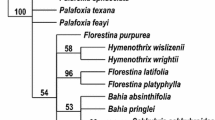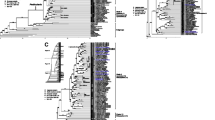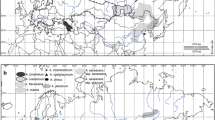Abstract
A phylogeny based on the internal transcribed spacer (ITS) sequences from 79 taxa representing much of the diversity of Berberis L. (four major groups and 22 sections) was constructed for the first time. The phylogeny was basically congruent with the previous classification schemes at higher taxonomic levels, such as groups and subgroups. A notable exception is the non-monophyly of the group Occidentales of compound-leaved Berberis (previously separated as Mahonia). At lower levels, however, most of previous sections and subsections were not evident especially in simple-leaved Berberis. Possible relationship between section Horridae (group Occidentales) and the simple-leaved Berberis clade implies paraphyly of the compound-leaved Berberis. A well-known South America-Old World (mainly Asia) disjunctive distribution pattern of the simple-leaved Berberis is explained by a vicariance event occurring in the Cretaceous period. The ITS phylogeny also suggests that a possible connection between the Asian and South American groups through the North American species (Berberis canadensis or B. fendleri) is highly unlikely.


Similar content being viewed by others
References
Ahrendt L (1961) Berberis and Mahonia, a taxonomic revision. Bot J Linn Soc 57:1–410
Cronquist A (1981) An integrated system of classification of flowering plants. Columbia University, New York
Doyle JJ, Doyle JL (1987) A rapid DNA isolation procedure for small quantities of fresh leaf tissue. Phytochem Bull 19:11–15
Fedde F (1902) Versuch einer Monographie der Gattung Mahonia. Bot Jahrb Syst 31:30–133
Felsenstein J (1985) Confidence limits on phylogenies: an approach using bootstrap. Evolution 39:783–791
Felsenstein J (1988) Phylogenies from molecular sequences: inference and reliability. Annu Rev Genet 22:521–565
Hoot SB, Crane PR (1995) Inter-familial relationships in the Ranunculidae based on molecular systematics. Plant Syst Evol 9[Suppl]:119–131
Huelsenbeck JP, Ronquist FR (2001) MrBayes: Bayesian inference of phylogenetic trees. Bioinformatics 17:754–755
Judd WS, Campbell CS, Kellog EA, Stevens PF, Donoghue MJ (2002) Plant systematics: a phylogenetic approach. Sinauer, Sunderland
Kim K-J, Jansen RK (1994) Comparison of phylogenetic hypotheses among different data sets in dwarf dandelions (Krigia): additional information from internal transcribed spacer sequences of nuclear ribosomal DNA. Plant Syst Evol 190:157–185
Kim Y-D, Jansen RK (1995) Phylogenetic implication of the chloroplast DNA variation from the Berberidaceae. Plant Syst Evol 9[Suppl]:341–349
Kim Y-D, Jansen RK (1998) Chloroplast DNA restriction site variation and phylogeny of the Berberidaceae. Am J Bot 85:1766–1778
Lafferriere JE (1997) Transfer of specific and infraspecific taxa from Mahonia to Berberis (Berberidaceae). Bot Zhurn 82:95–99
Landrum L (1981) The phylogeny and geography of Myrceugenia (Myrtaceae). Brittonia 33:105–129
Landrum L (1999) Revision of Berberis (Berberidaceae) in Chile and adjacent southern Argentina. Ann Mo Bot Gard 86:793–834
Loconte H, Estes JR (1989) Phylogenetic systematics of Berberidaceae and Ranunculales (Magnoliidae). Syst Bot 14:565–579
Loockerman DJ, Jansen RK (1996) The use of herbarium material for DNA studies. In: Stussey TF, Sohmer S (eds) Sampling the green world. Columbia University, New York, pp 205–220
Magallon S, Sanderson MJ (2001) Absolute diversification rates in angiosperm clades. Evolution 55:1762–1780
Meacham CA (1980) Phylogeny of the Berberidaceae with an evaluation of classifications. Syst Bot 5:149–172
Orsi MC (1976) Sinopsis de las especies Argentinas del género Berberis (Berberidaceae). Bol Soc Argent Bot 17:127–149
Rannala B, Yang Z (1996) Probability distribution of molecular evolutionary trees: a new method of phylogenetic inference. J Mol Evol 43:304–311
Raven PH, Axelrod DI (1974) Angiosperm biogeography and past continental movements. Ann Mo Bot Gard 61:539–673
Saitou N, Nei M (1987) The neighbor-joining method: a new method for reconstructing phylogenetic trees. Mol Biol Evol 4:406–425
Schnabel A, Wendel JF (1998) Cladistic biogeography of Gleditsia (Leguminosae) based on ndhF and rpl16 chloroplast gene sequences. Am J Bot 85:1753–1765
Schneider CK (1905) Die Gattung Berberis (Euberberis). Vorarbeiten für eine Monographie. Bull Herb Boissier Ser 2 5:33–48, 133–148, 391–403, 449–464, 655–670, 800–812, 813–831
Soltis DE, Tago-Nakazawa M, Xiang Q-Y, Kawano S, Murata J, Wakabayashi M, Hibsch-Jetter C (2001) Phylogenetic relationships and evolution in Chrysosplenium (Saxifragaceae) based on matK sequence data. Am J Bot 88:883–893
Suh Y, Thien LB, Reeve HE, Zimmer EA (1993) Molecular evolution and phylogenetic implications of internal transcribed spacer sequences of ribosomal DNA in Winteraceae. Am J Bot 80:1042–1055
Swofford DL (2002) PAUP*, phylogenetic analysis using parsimony (*and other methods), version 4.0b. Sinauer, Sunderland
Swofford DL, Olsen GJ, Waddell PJ, Hillis DM (1996) Phylogenetic inference. In: Hillis DM, Moritz C, Mable BK (eds) Molecular systematics, 2nd edn. Sinauer, Sunderland, pp 407–514
Terabayashi S (1985) The comparative floral anatomy and systematics of the Berberidaceae. II. Systematic considerations. Acta Phytotax Geobot 36:1–13
Thompson JD, Higgins DG, Gibson TJ (1995) CLUSTAL W: improving the sensitivity of progressive multiple sequence alignment through sequence weighting, positions-specific gap penalties and weight matrix choice. Nucleic Acids Res 22:4673–4680
Thorne RF (1972) Major disjunctions in the geographic ranges of seed plants. Q Rev Biol 47:365–411
White TJ, Birns T, Lee S, Taylor J (1990) Amplification and direct sequencing of fungal ribosomal RNA genes for phylogenetics. In: Innis M, Gelfand D, Sninsky J, White T (eds) PCR protocols: a guide to methods and applications. Academic, San Diego, pp 315–322
Whittemore AT (1997) Berberis. In: Morin NR (ed) Flora of North America, vol 3. Oxford University Press, New York, pp 276–286
Yang Z (1994) Estimating the pattern of nucleotide substitution. J Mol Evol 39:105–111
Acknowledgements
We thank Arnold Arboretum, Gray Herbarium, Edinburgh Botanical Garden, University of Texas Herbarium, Drs. J. Panero, and M. Chase for providing leaf or DNA materials, and Dr. C. Ulloa for identifying some South American species. This work was supported by grant (2000-2-201-00-001-2) from the Korea Science and Engineering Foundation.
Author information
Authors and Affiliations
Corresponding author
Rights and permissions
About this article
Cite this article
Kim, YD., Kim, SH. & Landrum, L.R. Taxonomic and phytogeographic implications from ITS phylogeny in Berberis (Berberidaceae). J Plant Res 117, 175–182 (2004). https://doi.org/10.1007/s10265-004-0145-7
Received:
Accepted:
Published:
Issue Date:
DOI: https://doi.org/10.1007/s10265-004-0145-7




